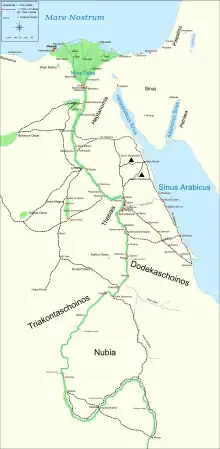
The Via Hadriana was an ancient Roman road established by the emperor Hadrian, which stretched from Antinoöpolis on the River Nile to the Red Sea at Berenice Troglodytica (Berenike). Hadrian had founded Antinoöpolis in memory of his presumed lover, the youth Antinous, who had drowned in the Nile. The Via Hadriana was finished in 137 AD. Traces of the road line were noted by Couyat (1910)[1] and Murray (1925)[2] who recorded the sites of several small mansiones in the southern part of the road. However, few were in the north and none at all were on the west-east stretch between Antinoöpolis and the coast. Many of these road stations had fortified watering points (hydreumata), which are likely to have given their name to the Hadhramaut on the other side of the Red Sea.[3]
References
- ↑ Couyat, Jules (1910). "Ports gréco-romains de la mer Rouge et grandes routes du désert arabique". Comptes rendus des séances de l'Académie des Inscriptions et Belles-Lettres (in French). 54 (6): 525–542. Retrieved 2 January 2021.
- ↑ Murray, G.W. (Oct 1925). "The Roman Roads and Stations in the Eastern Desert of Egypt". The Journal of Egyptian Archaeology. 11 (3/4): 138–150. doi:10.2307/3854133. JSTOR 3854133.
- ↑ Sidebotham, Speven E.; Zitterkopf, Ronald E. (1997). "Survey of the Via Hadriana by the University of Delaware: the 1996 season". Bulletin de l'Institut Français d'Archéologie Orientale. 97: 221–237. Retrieved 2 January 2021.